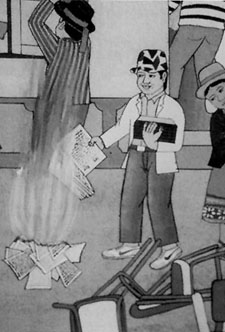![]()
![]() INTRODUCTION
INTRODUCTION
On May 17th, 1980 a small group of young men raided the polling |
 |
Within a few years Sendero Luminoso had shrewdly turned a critical national situation to their advantage by exacerbating class consciousness and social resentment among the indigenous people of the highlands. Although considered a legitimate insurrection by some and a repressive, reactionary movement by others, no one can deny the violence and bloodshed directly and indirectly attributed to the emergence of Sendero Luminoso. With the beginning of the urban strategy in the late 1980s and the involvement in the coca trade in the Upper Huallaga Valley soon after, it seemed all of Peru was a war zone. Flagrant human rights abuses by the military and its U.S.-trained counter-guerrilla forces (Sinchis) and the numerous killings of independent grass roots organizers, local politicians and unsympathetic civilians by Sendero Luminoso left the people of Peru caught in the middle.
Then on September 12, 1992 Presidente Gonzalo (Guzmán’s nom de
guerre) was captured during a raid of a safe house in Lima. Considerably weakened, Sendero
has lost much of its role in determining the future of Peru. But although it no longer
holds the country captive, it still remains a force to be reckoned with.
![]()